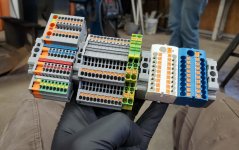Regarding the placement of VFDs.
VFDs generate heat and are also heat sensitive themselves. They may be rated to be able to sustain a high temperature, but that doesnt mean that you can operate them 100% at the highest rated temperature. Any VFD will be derated if it isnt operated at the 'nominal' temperature, typically 40°C.
Because of that, it makes sense to place VFDs at the bottom. If there are temperature sensitive components in the same enclosure it may be necessary with additional circulation or even cooling. If possible, place VFDs and PLCs in separate panel compartments.
Another thing is that it is the most convenient to terminate the motor cable directly at the VFD. Usually the cable screen can be terminated on the VFD chassis. That also speaks for placing the VFD at the bottom.
I've seen both and can understand both. We use many VFDs and always place at the bottom for the same reasons you mention. The cabling usually comes out of the bottom of our panels and that is closest to the VFD.
I have had some applications where all the cabling comes out the top of the enclosure, however, and place the VFDs on top in that case.




